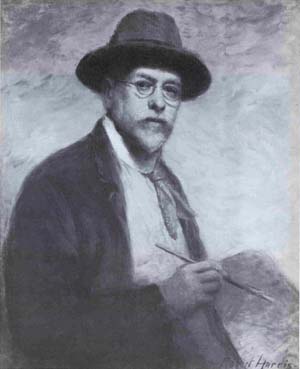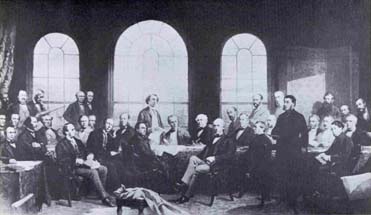
Bulletin 12 (VI:2), 1968
Home
Français
Introduction
History
Annual Index
Author &
Subject
Credits
Contact


Robert
Harris and The Fathers of Confederation
by Moncrieff Williamson
Résumé en français
Pages 1 | 2 |
3 | 4
| 5 | 6
Writing to his brother
Eddie on 15 May 1883, Robert Harris (fig. 1) began as
follows: "I'm just going to scribble this line to tell you the
picture for the Govt. is to be all right. So I shall be able to work
on it at home all summer I suppose, which will be o.k. However I shall have to go up to Toronto on the 29th to attend the meeting of
the Academy and then hope to skip for old P. E. I. with
speed." (1) The same day he wrote to his mother giving her
similar information; both letters were addressed from 656 Palace
Street, Montreal. Less than a month earlier, on 21 April, Harris had
written to his mother that "I found nothing definitely arranged
about the big picture for Ottawa."
These letters mark the start, but by no means the conclusion, of
what began as casual enough negotiations between the Department of
Public Works, Ottawa, and Robert Harris for one large painting in
oils on canvas (fig. 2) (2) to commemorate the gathering of Delegates
of British North America who met in Charlottetown, Prince Edward
Island, in September 1864 to discuss Maritime Union and eventually
established the Confederation of the Provinces of Canada. In October
1864, an additional twelve delegates had joined the others in Quebec
City, where the final points of Confederation of the Dominion of
Canada were worked out. The picture was to hang in the Railway
Commit tee Room of the House of Commons. The negotiations with
Harris dealt with the location of the scene to be depicted - whether
Charlottetown or Quebec City - and the matter of copyright.
In a letter to Sir Joseph Pope dated 25 April 1916, Harris wrote:
"The price agreed on with the Govt. was four thousand dollars
for painting the Charlottetown conference. This was changed later to
the Quebec conference as you know, containing as well as I remember
ten or twelve portraits more. Friends advised me to ask for a larger
sum in consequence but I did not thinking it would seem grasping to
do so being glad to get the commission and also expecting the value
of the copyright to be considerable. As a matter of fact I never got
from any source one cent more than the four thousand the Govt. gave
me." (3)
How many artists will sympathize with Harris's statement that he did
not wish to seem grasping, "being glad to get the
commission!" Indeed, Harris realized that, with the solid sum
of four thousand dollars, not only could he marry his beloved Bessie
(4) but he would also be able to go abroad to study and live a
life of modest economic independence.
"In this sum," Harris continues in his letter to Pope,
"the large expenses connected with the production of the
painting made a terrible hole. It involved a lot of travelling up
and down and was altogether very costly. I went to see almost every
one of the actors then alive and consulted relatives of those who
were dead. Altogether tried to reconstruct the scene on the spot
where the burnt Quebec building stood. In short I shirked no trouble
about it down to the landscape they must have looked on, feeling all
the time it was an opportunity to produce something which ought to
be of value in the annals of Canada." (5)
An artist of great skill, and certainly the one Canadian painter to
whom the government was apparently willing to entrust the
recording of such an historic event, Harris was also sufficiently
practical to recognize that what the Government wanted was, not a
work of art, but an archive: "I hoped it might have been
preserved many hundreds of years as barring an accident it was good
for any time and would in future have come to be looked on as a valuable
historical document" (my italics). (6)
In a way, Harris's wish was fulfilled. For, although the painting
was destroyed in the fire which burned the Parliament Building on 3
February 1916, it is well known even to the present generation of
Canadians. Owing to governmental indifference or laxity, the
painting had been copied and reproduced without permission,
discretion or accuracy. It was reproduced in school books, magazines
and newspapers, and hung in classrooms. Even Government departments
apparently were indifferent to copyright infringements for which
the injured artist would today be awarded punitive costs.
In February 1918, less than a year before his death, (7) Harris had
occasion to write to a Mr. E. J. Lemaire, Superintendent at the Post
Office, who had inquired about a detail in the postage stamp issued
to commemorate the Fiftieth Anniversary of Confederation. "The
object you refer to," wrote Harris, "represents two maps
rolled up under a stool and a light overcoat lying upon it. Used
chiefly as being effective in composition and colour. Referring to
the postage stamp, I think it a pity no one thought fit to consult
me on the matter: I should have been able to suggest use of the
picture without the sacrifice of the small group of men on the
extreme right, whose descendants may not unnaturally feel aggrieved
at their omission." (8)
What went wrong? Robert Harris was thirty-four years old and a
founding member of the Royal Canadian Academy (9) when he undertook
this commission. He must have been well-informed regarding copyright
laws, especially as he made so much of his livelihood as an
illustrator. At this late date we can only guess at the contents and
nature of the correspondence which passed between Harris and the
Department of Public Works, for here again fire intervened: in 1897
the offices of the Department of Public Works were burned to the
ground and the Harris correspondence destroyed.
That Harris had been demanding copyright from the
beginning is confirmed by the fact that in submitting his bill for
the painting he asked that the copyright be left with him. (10)
There is no record of a reply to this request, but on 5 June 1884
the Governor General approved an Order-in-Council authorizing the
Government to purchase the picture. The order was first drafted in
committee and then submitted to the Governor General by Sir John
A. Macdonald. (11)
Next Page | Minister
of Public Works
1 | 2 |
3 | 4
| 5 | 6
Annual Index | Author & Subject | Credits | Contact
This digital collection
was produced under contract to Canada's Digital Collections program,
Industry Canada.
"Digital
Collections Program, Copyright
© National Gallery of
Canada 2001"